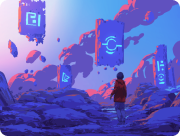Joris Dormans tells the story of how Machinations came to be
The first episode of our Fireside Chat Series: Mihai Gheza and Joris Dormans – the creator of the Machinations framework – talk about game design, Machinations, and the industry.
The digest
1. The Machinations framework emerged from Joris’ interest in studying games at a formal level, from a semiotics standpoint.
“I was reading about feedback loops in games, and that connected for me. The theory was (…) if you understand structural feedback, you understand the dynamics of games. I was looking at different available frameworks, and started using UML diagrams (…), and that helped to visualise (…) feedback loops, but I wasn’t really happy with the UML because it was way too bloated. I wanted to have something that you could easily write down on a piece of paper or a steamed bathroom mirror.”
2. Joris’ advice for those who want to really understand games
“If you want to understand games, you need to understand the emergent nature of games and the feedback structure that drives that behaviour. (…) As an advice (…): <<Focus on the larger structures first, don’t worry about details too much, initially. If you’re learning the framework, try to craft bigger structures and then get into the details in the later stage, to make an accurate simulation of something. But if you want to understand the nature of a game in a broad stroke, a simple diagram and a few elements can be very valuable. Then you can zoom in and add more detail.”
3. Machinations’ syntax becomes important when looking to identify the structure of a game, which’s not necessarily apparent when you play it.
“Machinations is a thinking tool – it helps you think about the problems you have in a game or how to think about its structure. [At first,] don’t worry about the numbers too much – you know, the amount that Source is going to produce.”
He recommends focusing on the structure of the game initially, and how everything works together, “until that point, it’s actually almost the same as Petri Nets – but the real trick is putting in State Connections: how does the state of one element affect the flow or state of others (…) because that technically closes the feedback loops.”
4. If Machinations were to be a foreign language that you learn, think about identifying patterns, like positive feedback loops, and then use the individual elements the same way you’d use words, to make up a phrase, with a specific syntax.
5. About the industry and where it’s headed
“I like the games industry because it’s ever-changing. (…) It’s such a dynamic field, there’re always new things coming up (…) What I hope for the industry is to get better along with academia (…) If people are better trained, (…) we will have better games, not just because the design techniques are better, but also because the critical skills coming into the design are better. (…) I hope they will grow together. (…) And Machinations is one of the things that manages to bridge the gap: used in research, taught in universities, and used in the industry, and hopefully, that puts us on the same wavelength.”
6. Another piece of advice for those of you who want to pick up Machinations
“It might take some time to get to grip with the framework, to understand what it’s all about, but once you get into that it feels like a jacket that you can wear when you need it… it’s a frame of mind, a role that you slip into.”
Enjoy watching the episode in full.
References:
Joris’ PHD paper
Dormans, Adams, Game Mechanics: Advanced Game Design
Ralph Koster
Doug Church

